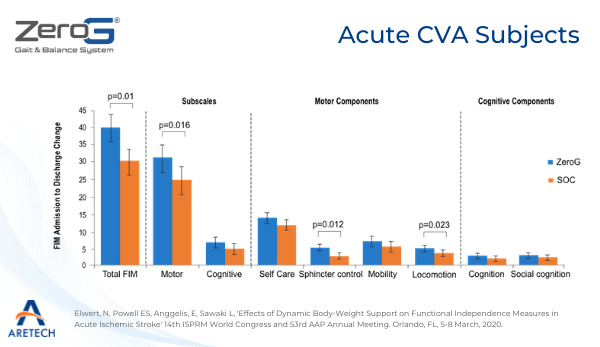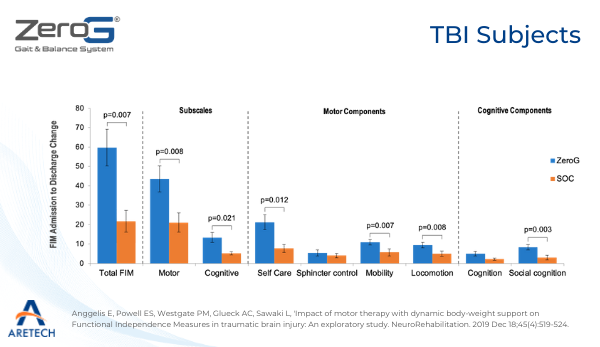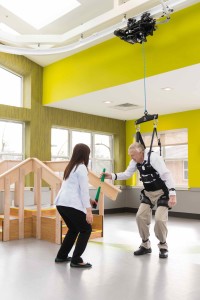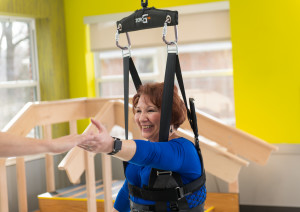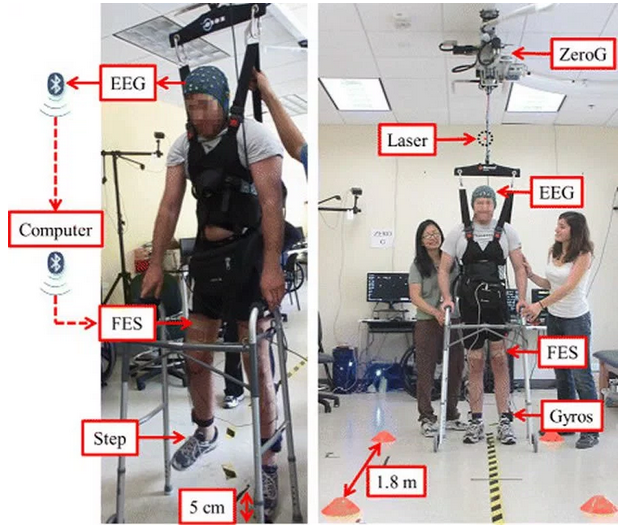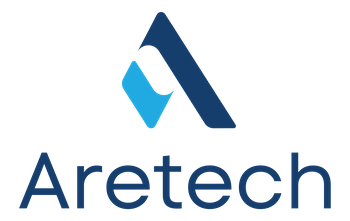ZeroG Leads to Better Outcomes
New Clinical Research Demonstrates Therapy with ZeroG Leads to Better Patient Outcomes
Aretech, LLC, a world leader in robotic body-weight support systems, announced today that multiple recently published research studies demonstrate that patients who use the ZeroG Gait and Balance System during inpatient rehabilitation achieve significantly higher clinical outcomes when compared to traditional standard of care (SOC) therapy. (1,2,3)
These studies, which were conducted in patients with acute stroke and acute traumatic brain injury, highlight ZeroG’s unique ability to provide dynamic body-weight support, controlled perturbations, and fall protection, which help patients achieve better outcomes.
One peer reviewed study performed at Gaylord Specialty Healthcare (Wallingford, CT), provides the first published evidence for the effectiveness of incorporating overground TRiP perturbations into gait rehabilitation in patients following stroke. TRiP (Training Responses in Postural Rehabilitation) is used to apply controlled perturbations of various strengths and directions to the patient while using the ZeroG robot. The Gaylord study found that patients treated with ZeroG and TRiP achieved significantly higher gains in Berg Balance scores when compared to Standard of Care. These findings suggest physical therapy that includes ZeroG with TRiP may help lower fall risk!
“We were impressed with the degree of balance improvement in the group that used ZeroG with TRiP during their inpatient rehabilitation.” says Pete Grevelding, PT, MSPT, NCS, Vice President of Clinical Operations at Gaylord Specialty Healthcare and Executive Director of the Milne Institute for Healthcare Innovation. “ZeroG with TRiP provides unanticipated perturbations while a patient is walking or practicing postural activities. These balance disruptions allow the patient to develop more effective recovery strategies, without the risk nor interference of manual intervention by the therapist. These relearned strategies potentially help avoid a harmful fall once back in the community. This study is the first to demonstrate that perturbations delivered during overground therapy activities can have a significant effect on improving patient outcomes.”
Joe Hidler, PhD, Aretech CEO, states “TRiP is one of the many ZeroG features that therapists are excited to use with their patients. What the Gaylord study shows is that challenging a patient’s balance control using ZeroG with TRiP may ultimately lower fall risk and improve functional independence.”
Two other studies evaluated the clinical effects of using ZeroG during inpatient rehabilitation following acute traumatic brain injury (TBI) and stroke. Each found that patients using ZeroG achieved significantly higher gains in total Functional Impairment Measure (FIM) scores then patients who receive SOC therapy. Specifically, the patients with acute stroke who used ZeroG during their daily therapy program improved their overall FIM score by 40 points while the SOC group improved by 30.5 points. Patients with acute TBI who used ZeroG during acute rehabilitation improved their overall FIM score by 59.7 points. This was nearly triple the gains in the SOC group, which were 21.1 total FIM.
“We are very excited by the results of these studies,” said Joe Hidler. “We have always believed that ZeroG’s unique ability to help deliver high-intensity physical therapy early after neurological injuries would lead to best outcomes. These studies now support this. And to see patients who use ZeroG with TRiP experience the largest gains in balance scores emphasizes the impact ZeroG can have on patient outcomes that cannot be replicated by other systems.”
References
1. Anggelis E, et al. “Impact of motor therapy with dynamic body-weight support on Functional Independence Measures in traumatic brain injury:” NeuroRehabilitation. 2019 Dec 18;45(4):519-524
2. Elwert N, Powell ES, Anggelis E, Sawaki L, “Effect of dynamic body-weight support on function independence measure in acute ischemic stroke.” 14th ISPRM World Congress and 53rd AAP Annual Meeting. 2020
3. Meyer et al. “A Novel Body Weight-Supported Postural Perturbation Module for Gait and Balance Rehabilitation After Stroke: Preliminary Evaluation Study” JMIR Rehabil Assist Technol. 2022;9 (1)
About ZeroG TRiP
TRiP (Training Responses in Postural Rehabilitation) is a patent pending software algorithm for the ZeroG Gait and Balance System. TRiP allows therapists to apply controlled and measurable perturbations to patients while ambulating or during stationary activities using the ZeroG robot.
About the ZeroG Gait and Balance System
The ZeroG Gait and Balance System has been used by patients since 2008 and is intended for patients in rehabilitation who need dynamic body-weight support and are at a risk of falling. ZeroG gives therapists the opportunity to safely treat a broad range of patient populations with dynamic body-weight support in functional activities, apply TRiP perturbations while providing fall protection.
About Aretech
Aretech, LLC, headquartered in Ashburn, Virginia, is a world leader in developing advanced rehabilitation technologies for improving function and independence. The company has a strong commitment to quality, innovation, and developing technology based on evidence-based research.

